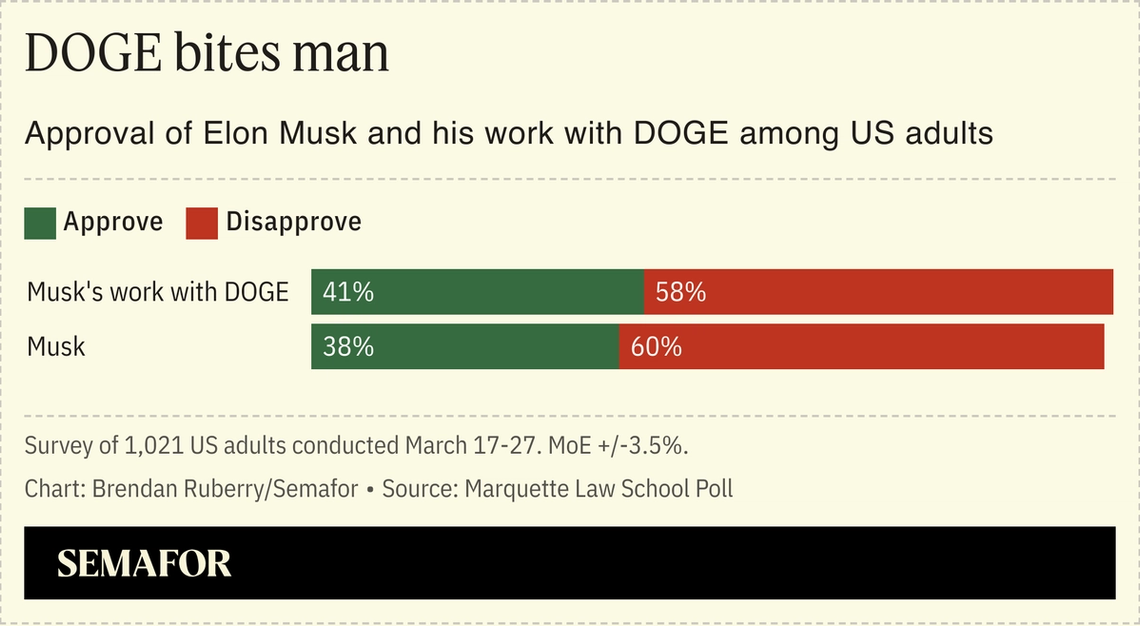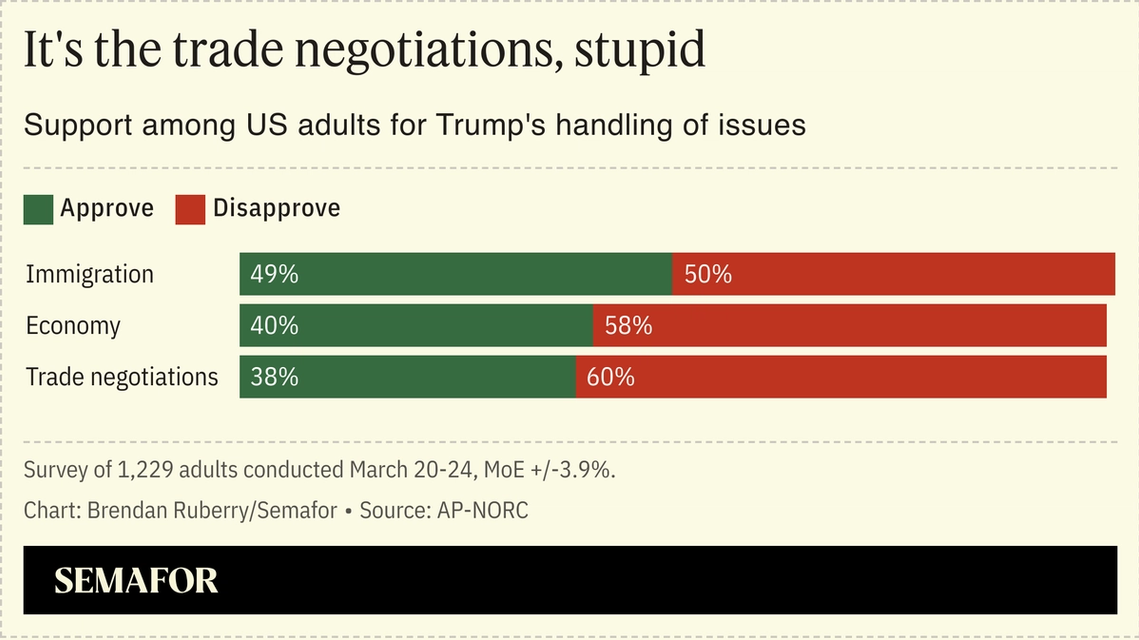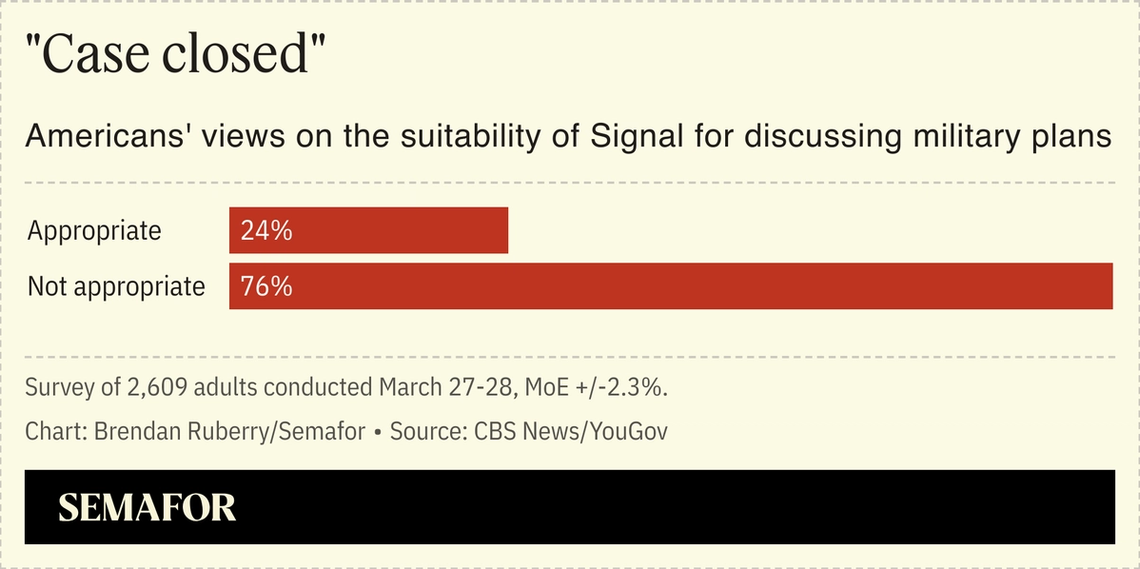 Polls If it wasn’t clear from the Wisconsin supreme court race that voters are angry at DOGE and its leader, this Wisconsin pollsters’ numbers underscore that sentiment. Elon Musk’s personal popularity has tumbled with non-Republicans, and the idea of a government efficiency task force is more popular than the reality. Musk and DOGE are marginally less popular than Trump, thanks to lower support from independents, and have slightly less support from self-identified Republicans. Musk had crossover appeal in 2024, and it’s largely vanished this year.  Immigration was one of Trump’s best issues in the 2024 campaign, and it’s consistently been the highest-polling part of the agenda since he returned to office. Democrats, who constantly rose up to attack Trump over deportations in the first term, have been more careful this time; activists complain they’ve even said too little about the deportations of non-citizens who had legal status, but were critical of Israel. But their quiet, and quiet on the border, has meant less attention paid to the issue overall. There’s much more coverage of the economy, and much more opposition to Trump’s use of tariffs — and they’re his weakest issues right now. This poll found the same skepticism about Trump and trade in his first term, giving him just a 40% approval rating on the issue when it last asked about it, in Jan. 2020. But voters then separated the trade threats from their view of the economy, which was overwhelmingly positive. Now, the two topics are interlinked.  The Signal scandal was the first damaging story about the Trump administration that significantly angered Republicans. They’ve been sympathetic to the president during other media frenzies, but they break off here. Fifty-six percent of Republicans agree that the war room group chat shared accidentally with The Atlantic’s Jeffrey Goldberg should not have happened. They’ve also heard less about this than non-Republicans, but most (64%) say they’ve seen “a lot” or “some” news about it. Other administrations sometimes appointed special counsels or endorsed FBI investigations to probe breaches like this, which have dragged them across news cycles. This one said “case closed” and pressed on. When Politico reported that NSA Michael Waltz had launched more Signal groups to discuss sensitive information, the administration just said that none of the information on them was classified. (“Don’t bring that up again,” Trump said Thursday, when asked about the stories on Air Force One.) Ads Jimmy Patronis for Congress/YouTube Jimmy Patronis for Congress/YouTube- Friends of Jimmy Patronis, “They Hate All of Us.” Republicans didn’t sweat the race for Florida’s 1st Congressional District, and didn’t worry when Patronis, the state’s chief financial officer, won it by less than half as much as Matt Gaetz did last year. Northwest Florida simply didn’t want to elect a Democrat, a correct assumption that built this ad. “These radical Democrats hate President Trump, and hate all of us that voted for him,” says a female narrator, after footage of Democrat Gay Valimont criticizing “President Musk” and participating in protests.
- Josh Gottheimer for Governor, “Crazy.” The New Jersey congressman has run for governor as a pragmatic Trump-fighting liberal obsessed with lowering the cost of living. He’s run one of the first ads that discusses tariffs as new problems caused by Republicans, not warnings of what they could do. “Insane tariffs, jacking up prices, threatening the economy,” says Gottheimer, promising a suite of tax cuts that will make it easier for New Jersey to endure it all.
- Fulop for Governor, “Steps.” Jersey City’s mayor has been running for governor for two full years, jumping ahead of candidates who’d end up getting more support from local parties and electeds. He’s continued to treat that like a strength: “Since when did anyone in New Jersey let someone tell them what they can or can’t do?” To dramatize his youth, vigor, and independence, he races up his city’s “100 Steps,” a project finished right after he became mayor.
Scooped!We’ve closely covered the Republican effort to take the “T” out of “LGBT,” and the implications of Trump’s inauguration day order to recognize two, unchangeable biological sexes in the law. Benjamin Ryan and Aria Bendix identified a major implication of that — the erasure of more than $125 million in grants for LGBT health research. They got the first statement on this I’ve seen from the new team at NIH, that moving “away from politicized DEI and gender ideology studies” means ending research that had transformed understanding of AIDS and options for preventing its transmission. Next - 67 days until primaries in New Jersey
- 74 days until primaries in Virginia
- 81 days until primaries in New York City
- 214 days until off-year elections
- 577 days until the 2026 midterm elections
David RecommendsThe Biden campaign books are finally here, written in post-election flurries of activity and angst. “Fight,” the Allen/Parnes collaboration I quoted at the top of this newsletter, is very worth reading — the best of their three campaign books, full of not just news (the failed negotiation to get Kamala Harris on Joe Rogan) but insights. Trump really did think he could lose the election; his team was genuinely worried about Biden dropping out of the race; he and Barack Obama undermined her in ways that make you question how serious they were about democracy itself being at stake. (One favorite anecdote: After Biden quit, a call was scheduled between him and Obama just to kill a story about how their friendship was kaput and they hadn’t talked.) You have 500 or so more pages of these books coming, so get cracking. |